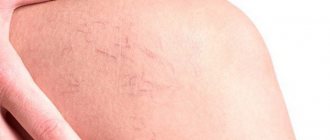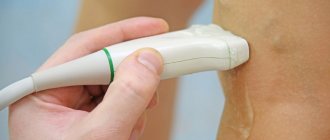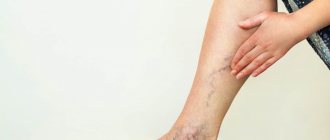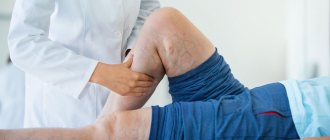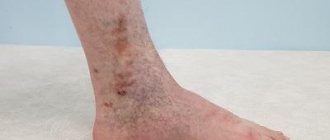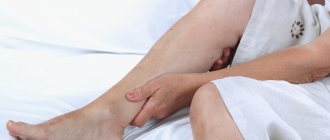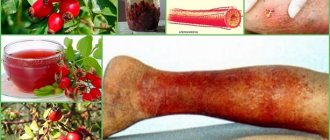July 27, 2020
Varicose veins are dilation of the superficial veins of the lower extremities, accompanied by valve incompetence and impaired blood flow.
Varicose veins are dilation of the superficial veins of the lower extremities, accompanied by valve incompetence and impaired blood flow. The term “ varicose veins ” comes from Lat. varix - “swelling”. This diagnosis is very widespread: up to 89% of women and up to 66% of men living in developed countries have signs of varicose veins to one degree or another.
Most often, the valves that are subject to maximum mechanical stress are the first to be affected. In this case, pathological discharge of blood occurs through the mouth of the great and small saphenous veins, sometimes through large perforating veins. Excessive blood volume arising in the superficial veins gradually leads to overstretching of the venous wall. The total volume of blood contained in the superficial venous bed of the lower extremities increases, resulting in dilatation and valvular insufficiency in the perforating veins. Varicose veins most often affect the veins of the lower extremities, but can occur in any organ or part of the body.
How were varicose veins treated before?
Currently, various techniques are used to treat varicose veins, from ultra-modern ones that have appeared in recent years to archaic ones, whose history goes back to the beginning of the last century. The latter include surgical operations to remove varicose veins: crossectomy, phlebectomy and stripping.
View of the leg after classic vein surgery
These operations have become firmly established in surgical practice and are still performed en masse in various medical institutions. The most popular is the old varicose vein surgery in public hospitals. The method of surgical removal of veins has been tested over decades of practice, but it also has significant disadvantages. These are complications and side effects associated with surgical trauma, incisions, and anesthesia used during these operations. Modern methods of treating varicose veins of the lower extremities are obviously more effective and have fewer side effects. The disadvantage of modern methods of treating varicose veins of the lower extremities is the cost of equipment and requirements for the training of medical personnel.
Varicose veins of the lower extremities - stages
There are several stages of disease development:
- compensation – spider veins and tortuous veins appear on the legs, no complaints
- subcompensation – there are complaints of swelling, cramps of the calf muscles, a feeling of heaviness, fatigue in the legs, pronounced dilated veins are visually determined
- decompensation – dermatitis, minor hemorrhages are added, the skin becomes dense, dry, easily wounded, pigment spots appear
The earlier the disease is detected, the easier it is to treat.
What methods of treating varicose veins do modern phlebologists use?
The following methods of treating varicose veins can be considered modern:
- Endovenous laser coagulation.
- Radiofrequency obliteration.
- Steam obliteration.
- Mechanochemical obliteration.
- Adhesive obliteration.
All these methods of treating varicose veins can be considered modern. They are high-tech and are currently used in European clinics. However, not all of these modern technologies can be called ideal or close to perfect. The structure of commercial medicine places increasingly high demands on modern methods. These are efficiency, safety, minimally invasiveness, ease of use and versatility when removing a wide variety of varicose veins. Of the above, only one method of modern treatment of varicose veins satisfies all these requirements. This is endovenous laser coagulation or obliteration (EVLK, EVLO). It is laser obliteration that is used by leading phlebologists today all over the world to treat a wide variety of variants of varicose veins.
This is how phlebologists currently treat varicose veins
Several years ago, new laser generators with a wavelength of 1940 nm, the latest Swift radial light guides appeared, and the tactics of endovasal intervention itself changed. The method is being progressively developed even now. Today it is difficult to name those clinical tasks that endovenous laser obliteration cannot cope with. Therefore, it is the most modern method of treating varicose veins at present.
Varicose veins of the lower extremities - diagnosis
To accurately diagnose the disease, you must consult a doctor. Vascular surgery deals with varicose veins of the lower extremities. To make a diagnosis, in addition to complaints and visual examination, it is necessary to use special research methods.
Ultrasound diagnosis of varicose veins of the lower extremities
Duplex angioscanning is considered the gold standard. This method combines ultrasound and Doppler scanning. Thus, it is possible to see the condition of the vascular wall in real time and assess the speed of blood flow in the venous system of the lower extremities.
Questions from patients about modern methods of treating varicose veins
What methods of treating varicose veins does a modern phlebologist use?
A modern European phlebologist uses the following methods for treating varicose veins: endovenous laser coagulation (EVLC), microphlebectomy and compression sclerotherapy (scleroobliteration).
What is the most modern method of treating varicose veins?
Currently, the most modern and effective method of treating varicose veins is endovenous laser obliteration (coagulation).
How are modern methods of treating varicose veins better than other methods?
Modern endovascular (intravascular) methods of treating varicose veins have the following advantages: high efficiency, minimal surgical trauma, allow the use of local anesthesia, complete outpatient care and almost complete absence of complications.
What qualities should a modern method of treating varicose veins have?
A modern method of treating varicose veins should have the following qualities:
- Outpatient implementation, no need for hospitalization.
- Efficiency, recurrence of the disease in any form is unacceptable.
- There are no skin incisions, the only invasion is skin punctures.
- Ability to use local anesthesia in most cases.
Pharmacy help for varicose veins!
Chronic venous insufficiency (CVI)
- a disease known since the time of Hippocrates. At that time, this disease was called “a disease that knocks you down” and even then they tried to treat it surgically. Today, vein diseases are fought in a variety of different and even quite painless ways. Let's look at how to deal with chronic venous insufficiency using drugs from the pharmacy range.
Varicose veins most often mean dilatation of the superficial veins of the lower extremities, accompanied by valve incompetence and impaired blood flow. The prevalence of varicose veins is unusually wide.
In the initial stage, the disease manifests itself with a few and very nonspecific symptoms
:
• pain or feeling of heaviness in the legs; • burning sensation, pulsation; • night cramps in the calf muscles; • swelling and pain along the veins (often not yet dilated); • protruding veins, lumps in the legs, “webs” and “spider veins”; • slight swelling of the soft tissues, usually in the feet, ankles and lower legs.
In most cases, patients with varicose veins at the onset of the disease noted any of the listed symptoms. All these symptoms are usually more severe in the evening, after work, or during prolonged standing, especially in hot weather.
If left untreated, varicose veins can lead to serious consequences. Among them are blockage of blood vessels with blood clots, malnutrition of leg tissues, bleeding from varicose veins, hyperpigmentation of the skin, and trophic ulcers. Therefore, the question of how to maintain the condition of the veins and slow down the progression of this disease is relevant for many.
There are several factors that can lead to the occurrence of varicose veins:
• Constant work on your feet (pharmacists, teachers, athletes). • Work involving physical activity and heavy lifting. • Consequences of pregnancy. • Hereditary predisposition. • Sedentary lifestyle (overweight). • Bad habits (alcohol, smoking). • Taking hormonal medications.
In the modern world, it is not easy to eliminate all existing risk factors, so treatment of the disease must be comprehensive
• prevention of relapse of vein diseases; • preservation of working capacity; • improving quality of life (elimination of symptoms).
The main group of drugs are angioprotectors.
These drugs act on the cause of the disease, relieve vascular spasm, improve blood flow, normalize microcirculation and eliminate swelling. More often, therapy begins with external agents (Troxerutin DS, Venatrix, Venance Plus), subsequently adding drugs for internal use (Angiorus, Detralex). For the best effect, we recommend taking them together with herbal preparations. To maintain the elasticity of the capillary walls, Dihydroquercetin, Ascorutin, and Capilar are indicated. To relieve discomfort (pain, swelling, heaviness), you can use decongestants (Arnigel, Lyoton) and cooling agents for topical use (Afafrost, Simple recipe with menthol).
For varicose veins
in the evening, cramps of the lower extremities and a tingling sensation may often occur. To avoid these symptoms, you need to take calcium supplements (Calcium, Calcemin, Caldetrin, Calcium-D3 Nycomed). At an advanced stage of the disease, patients may experience itching and redness of the skin; to relieve such symptoms, we recommend antipruritic agents (Cikaderma, Akriderm, Neotanin).
To fix and support the veins, it is recommended to use compression hosiery of varying degrees of compression (elastic bandage, stockings, tights). Such products create measured pressure on the muscles and walls of the veins, narrowing the venous lumen, relieve swelling, accelerating the outflow of blood, and prevent the formation of blood clots. This measure is suitable for both treatment and prevention. To reduce the load on the lower limbs, it is recommended to use orthopedic or silicone insoles and heel pads.
Since excess weight is one of the factors in the development of varicose veins, we recommend means for regulating metabolism (Guarana and green tea complex, L-carnitine, Slim tabs). Products with low sugar content, bran and products containing fiber will be useful.
And remember that prevention of any disease is the easiest way to prevent it.
THERE ARE CONTRAINDICATIONS, YOU MUST READ THE INSTRUCTIONS OR CONSULT WITH A SPECIALIST.
Varicose veins of the lower extremities - prevention
For prevention, it is necessary first of all to adhere to the work regime. You cannot constantly be on your feet or sit in one position. From time to time it is worth taking short breaks to give your legs a rest.
After a hard day at work, you can massage your feet, after which it is advisable to put your feet on a raised platform. This improves blood flow from the extremities.
Exercises to improve venous blood flow in the legs
Don't get carried away with hot baths and saunas. To prevent varicose veins, it is much more useful to take a contrast shower and rinse your legs with cool water.
It is important to monitor your weight. Excess body weight increases the load on the venous system and contributes to the development of the disease.
If there is a predisposition to developing the disease, and it is not possible to eliminate all risk factors, it is better to engage in prevention. Even if the disease has already begun, do not despair. Varicose veins of the lower extremities are not a death sentence. By detecting the problem in a timely manner and contacting specialists, you can get rid of the disease and avoid serious complications.
We invite you to visit our specialist phlebologist and get rid of varicose veins in the early stages.
Varicose veins of the lower extremities - complications
If there are varicose veins of the lower extremities, treatment should begin faster, otherwise the disease will progress, which is fraught with serious complications. Stagnation of blood in the veins contributes to the formation of blood clots, phlebothrombosis develops, and if the vein also becomes inflamed, thrombophlebitis develops.
Acute thrombophlebitis of superficial veins
The resulting blood clots can break free from their place at any time and enter the bloodstream. In this case, the blood clot enters the veins of the lungs, blocking them. In this case, a person can die from suffocation even before the ambulance arrives, because such a formidable complication is extremely difficult to treat even in a specialized hospital, and there is very little time to save a life.
In addition, due to blood stagnation, nutrition of the lower extremities is disrupted. Deep trophic ulcers form on the skin, which heal poorly and tend to spread. This can lead to amputation of the limb.
Based on the fact that complications of varicose veins of the lower extremities are not at all harmless, it is necessary to contact a qualified specialist as soon as possible. Only a doctor can prescribe effective treatment and help avoid complications.
Varicose veins of the lower extremities - treatment with radiofrequency
How to remove varicose veins of the lower extremities? RFA treatment is of particular interest to patients. Why do many people dream of eliminating varicose veins of the lower extremities and prefer RFO treatment?
Radiofrequency ablation (RFA) is an operation that can be performed on an outpatient basis if you want to forget varicose veins of the lower extremities. RFA treatment in Moscow uses radio frequency, which is used to “seal” a vein and remove varicose veins of the lower extremities. RFO treatment in Moscow is fast and effective.
Causes of varicose veins
First of all, this is heredity: weak venous walls are a feature that is passed on from parents.
In addition to hereditary factors, vascular damage is promoted by:
- overload during sports training;
- sedentary work and a generally sedentary lifestyle;
- work on feet;
- taking hormonal contraceptives;
- pregnancy and childbirth;
- disturbances in the functioning of the endocrine system, leading to an increase in venous pressure;
- leg injuries;
- diseases of the pelvic organs;
- weakened immune system;
- excess weight;
- high growth;
- unbalanced diet;
- constipation;
- addiction to alcohol;
- smoking;
- excessive passion for tanning, sauna;
- tight clothes, shoes – uncomfortable or with high heels;
- stress, constant worries;
- elderly age.
It is noteworthy that varicose veins in women are diagnosed twice as often as in men. After all, it is the fair sex who wear high-heeled shoes, bear and give birth to children, and take hormonal contraceptives.
Also read the article varicose veins in men

